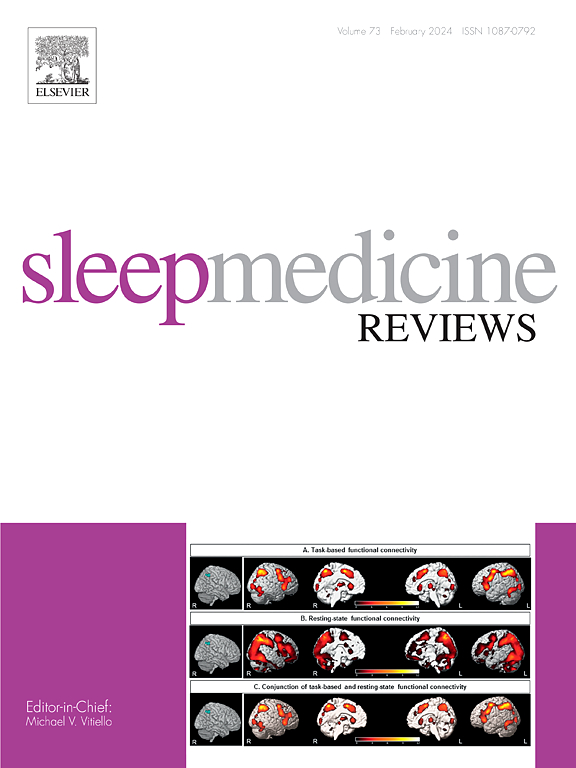Air pollution and sleep health in middle-aged and older adults: A systematic review and meta-analysis
IF 9.7
1区 医学
Q1 CLINICAL NEUROLOGY
引用次数: 0
Abstract
Exposure to air pollution may negatively impact sleep health. This systematic review and meta-analysis examined the association between air pollution and sleep health in middle-aged and older adults. PubMed, Web of Science, CINAHL and Embase were searched from inception to September 11, 2024. Included studies reported at least one air pollutant (e.g., PM1 [particles < 1 μm], PM2.5 [particles < 2.5 μm], PM10 [particles < 10 μm], CO [carbon monoxide], CO2 [carbon dioxide], NO2 [nitrogen dioxide], SO2 [sulfur dioxide] and O3 [ozone]) and sleep health outcomes. All binary negative sleep health outcomes (e.g., poor sleep quality, low sleep efficiency and obstructive sleep apnea) were integrated as poor sleep health in the meta-analyses. Twenty-five studies were included, with a final sample of at least 1,262,210 middle-aged and older adults. The pooled prevalence of poor sleep health was 43.7%. We conducted random-effects meta-analyses on nine studies using the DerSimonian-Laird estimator to examine the association between air pollution and poor sleep health. Results showed that per 10 μg/m3 increase in long-term exposure to PM1 [OR (95% CI): 1.37 (1.07, 1.75)], PM2.5 [OR (95% CI): 1.27 (1.12, 1.43), PM10 [OR (95% CI): 1.10 (1.03, 1.19) and per 5 μg/m3 in NO2 [OR (95% CI): 1.07 (1.01, 1.13)] was significantly associated with poor sleep health. However, no significant association was observed between long-term O3 exposure (per 10 μg/m3 increase) and poor sleep health [OR (95% CI): 1.04 (0.88, 1.24)]. Indoor air pollution from the combustion of solid fuels was also associated with a higher risk of poor sleep health. Our findings highlight the critical roles of both indoor and outdoor air environments in promoting sleep health, underscoring the need for environmental interventions and public health policies to improve air quality and alleviate the burden of poor sleep health.
空气污染与中老年人睡眠健康:一项系统综述和荟萃分析
暴露在空气污染中可能会对睡眠健康产生负面影响。这项系统回顾和荟萃分析研究了空气污染与中老年人睡眠健康之间的关系。PubMed, Web of Science, CINAHL和Embase从成立到2024年9月11日被检索。纳入的研究报告了至少一种空气污染物(例如,PM1[颗粒<;1 μm], PM2.5[颗粒<;2.5 μm], PM10[颗粒<;10 μm]、CO[一氧化碳]、CO2[二氧化碳]、NO2[二氧化氮]、SO2[二氧化硫]和O3[臭氧])与睡眠健康结果的关系。所有二元负面睡眠健康结果(如睡眠质量差、睡眠效率低和阻塞性睡眠呼吸暂停)在meta分析中被纳入睡眠健康不良。纳入了25项研究,最终样本至少有1262210名中老年人。睡眠健康不良的总患病率为43.7%。我们使用dersimonan - laird估计器对9项研究进行了随机效应荟萃分析,以检验空气污染与不良睡眠健康之间的关系。结果显示,长期暴露于每10 μg/m3的PM1 [OR (95% CI): 1.37 (1.07, 1.75)], PM2.5 [OR (95% CI): 1.27 (1.12, 1.43), PM10 [OR (95% CI): 1.10(1.03, 1.19))和NO2每5 μg/m3 [OR (95% CI): 1.07(1.01, 1.13)]与睡眠健康状况不佳显著相关。然而,长期臭氧暴露(每增加10 μg/m3)与睡眠健康状况不佳之间没有显著关联[OR (95% CI): 1.04(0.88, 1.24)]。固体燃料燃烧造成的室内空气污染也与睡眠健康状况不佳的风险较高有关。我们的研究结果强调了室内和室外空气环境在促进睡眠健康方面的关键作用,强调了环境干预和公共卫生政策改善空气质量和减轻睡眠健康不良负担的必要性。
本文章由计算机程序翻译,如有差异,请以英文原文为准。
求助全文
约1分钟内获得全文
求助全文
来源期刊

Sleep Medicine Reviews
医学-临床神经学
CiteScore
20.10
自引率
3.80%
发文量
107
期刊介绍:
Sleep Medicine Reviews offers global coverage of sleep disorders, exploring their origins, diagnosis, treatment, and implications for related conditions at both individual and public health levels.
Articles comprehensively review clinical information from peer-reviewed journals across various disciplines in sleep medicine, encompassing pulmonology, psychiatry, psychology, physiology, otolaryngology, pediatrics, geriatrics, cardiology, dentistry, nursing, neurology, and general medicine.
The journal features narrative reviews, systematic reviews, and editorials addressing areas of controversy, debate, and future research within the field.
 求助内容:
求助内容: 应助结果提醒方式:
应助结果提醒方式:


